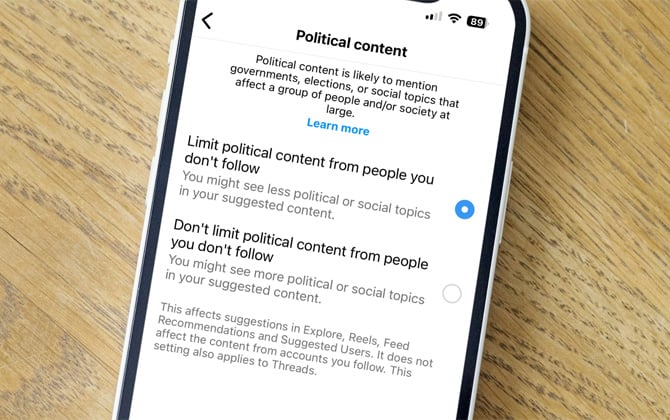If you're a regular on Instagram, you might have spotted some changes to the political content popping up in your feed. Meta, Instagram's parent company, has recently dialed back on pushing political posts from accounts you don't follow into your feed. This adjustment is particularly relevant now during the presidential election cycle, as social media's role in political conversation is seen as significantly influencing public opinion and our interaction with news and information.

Remember what it was like during the last presidential election? It was brutal. A September 2020 Pew Research Center study revealed that 55% of Americans felt overwhelmed by the barrage of political posts on social media.
Despite this, political engagement on social media remains robust. A June 2023 survey by Pew found that nearly half (46%) of social media users have actively engaged in political activities on these platforms over the past year. So, Instagram's strategy to scale back on political content could markedly change how we access and consume information on the platform.
Why Meta is limiting political content on Instagram
Meta's decision to limit the recommendation of political content from accounts that users don't follow comes in response to user feedback, with many people expressing a desire to see less political content in their feeds. In a statement, Meta said, "People have told us they want to see less political content, so we have spent the last few years refining our approach on Facebook to reduce the amount of political content – including from politicians' accounts – you see in Feed, Reels, Watch, Groups You Should Join, and Pages You May Like. We've recently extended this approach in Reels, Explore, and In-Feed Recommendations on Instagram and Threads, too."
By taking this step, Meta aims to prevent your feed from being filled with partisan posts and reduce exposure to potentially polarizing content. The company's goal is to "avoid making recommendations that could be about politics or political issues, in line with our approach of not recommending certain types of content to those who don't wish to see it."
Read more: How to Delete Your Meta Account Permanently
The implications of Meta's decision
Instagram's decision to limit political content recommendations has the potential to impact the platform in several ways. A primary goal of this change is to combat the spread of misinformation and reduce exposure to highly partisan content on Instagram. By limiting exposure to political posts from accounts you don't follow, Instagram aims to create a more balanced and less polarizing environment.
However, this decision has also raised concerns about its impact on free speech. Some critics argue that by limiting the reach of political content, Instagram may be stifling important conversations and restricting access to diverse perspectives.
A recent study published in Nature, entitled "Like-minded sources on Facebook are prevalent but not polarizing," sheds light on the potential implications of reducing exposure to content from like-minded sources on social media. The researchers conducted a field experiment on Facebook among 23,377 users, reducing their exposure to content from like-minded sources by about one-third during the 2020 US presidential election.
They found that the intervention increased exposure to content from cross-cutting sources and decreased exposure to uncivil language. However, the study also revealed that the intervention had no measurable effects on eight preregistered attitudinal measures, such as affective polarization, ideological extremity, candidate evaluations, and belief in false claims.
These findings suggest that while reducing exposure to content from like-minded sources on social media may increase exposure to diverse perspectives and decrease exposure to uncivil language, it may not necessarily lead to a reduction in polarization of beliefs or attitudes. This raises questions about the effectiveness of Instagram's decision in addressing the underlying issues of political polarization and the spread of misinformation on the platform.
Read more: Safeguarding Your Instagram Friends: Tips to Prevent Account Cloning
How to bypass political content curbs on Instagram
If you find that Instagram's decision to limit political content recommendations has left you wanting to see more diverse perspectives in your feed, you have the power to take control of your experience. The platform gives you the option to bypass these curbs, allowing you to curate your feed according to your preferences.
- On your Instagram profile page, tap the three-dash menu in the top right corner.
- In the "What you see" section, select "content preferences," then open the "Political content" menu.
- Find the "Don't limit" option and turn it on.
In addition to the "Don't limit" option, you may also want to explore the "Reduced by fact-checking" setting available in the Content Preference section. This setting applies to content that has been reviewed by independent fact-checkers and found to "contain false or partly false information, altered content, or missing context." By default, it is deprioritized in your feed.
You have three control levels to tailor your feed: "don't reduce," which lets content stay prominent; "reduce," the default, which nudges content lower, making it less visible; and "reduce more," which pushes content further down and possibly adds an overlay with details. Unless you like seeing wacky conspiracy theories on Instagram, I recommend using the most aggressive "reduce more" setting.
Final thoughts
As Instagram continues to navigate the challenges of moderating political content, the algorithm that determines the posts you see in your feed will inevitably change. With the right tools, you have the power to shape what you see and engage with the platform in a way that feels authentic and meaningful to you.
[Image credit: Screenshot via Techlicious, phone mockup via Canva]
For the past 20+ years, Techlicious founder Suzanne Kantra has been exploring and writing about the world’s most exciting and important science and technology issues. Prior to Techlicious, Suzanne was the Technology Editor for Martha Stewart Living Omnimedia and the Senior Technology Editor for Popular Science. Suzanne has been featured on CNN, CBS, and NBC.













